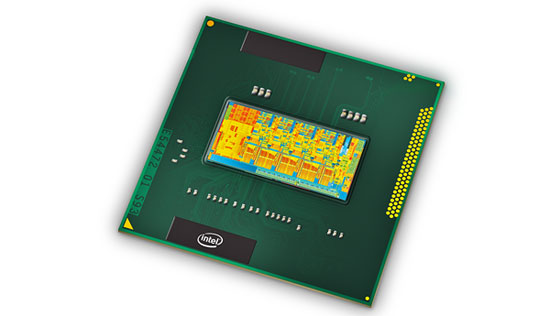Intel Core i7-2820QM Mobile Sandy Bridge Processor
Performance Summary: Intel's new Core i7-2820QM processor put up the fastest benchmark numbers we've seen from any notebook processor to date, with respect to general purpose computing workloads. In these test conditions, Intel's new Sandy Bridge mobile architecture offered performance gains of anywhere from 25 to over 50%, depending on thread-level workload. Where the Core i7-2820QM really excelled was within specialties like video encoding, gaming and encryption processing. Intel's new on-die IGP offered competitive performance to existing entry-level discrete and integrated mobile graphics solutions and out-paced previous generation Intel IGPs by as much as three-fold in our tests with FarCry 2 and Metro 2033. We saw a similar result within PCMark Vantage's Communications test, where Sandy Bridge's new AES instruction set offered over two times the performance of Intel's previous generation quad-core mobile architecture. Finally, our video encoding tests showed Sandy Bridge Quick Sync technology offers video encoding performance that rivals and surpasses dedicated GPU solutions in the market today, at least in the application we tested that were optimized to support the technology.
![]()
We're not sure what more there is to say that hasn't already been said in our evaluation and benchmark testing. If you're the type that likes to cut to the chase and just surf performance graphs, then, frankly, you've seen all there is to know about Intel's new mobile processor architecture for mainstream and high-end notebooks. Sandy Bridge is fast, crazy fast in fact. It consumes less power under load and has more aggressive clock gating when you're not using your machine but want to keep it at the ready with the lid up. Better still, Intel's latest, fully integrated HD Graphics core in the processor we tested, offers legitimate entry-level graphics capabilities for multimedia, video processing and light duty gaming. If you were previously looking for notebooks with discrete GPU solutions, just so you had some level of basic, dedicated graphics horsepower with current capabilities, we'd offer that you might not need to weigh that into your buying decision any longer. True mobile gamers are going to still going to want discrete GPUs but yes, Intel's integrated graphics solution, especially if they decide to resource driver development a bit more, could very well be, "good enough." And good enough doesn't mean you have to sacrifice much, in our book anyway.
Our only regret was that the test system we had to work with unfortunately won't see the light of day, as it was not intended to be a production model. However, though you can't buy the same system we tested, we're told Intel Sandy Bridge mobile processor-based notebooks will be launching in abundance over the next few weeks as we witness a multitude of unveilings at this year's Consumer Electronics show in Las Vegas. Typically we reserve our ratings and awards for products that you can actually buy but there are rare few exceptions where we offer them to a technology that will enable products to come in the market. This is definitely the case with Intel's new Core i7-2820QM processor and Intel's Sandy Bridge mobile notebook processor architecture. If we were in the market
for a notebook, whether it be thin-and-light or midrange, there's little
question a machine with one of Intel's new Sandy Bridge mobile chips
would be on our short list, more than once actually. If this is Intel's "tock" processor technology refresh, we can't wait to see the next "tick."

|
|
|
|








